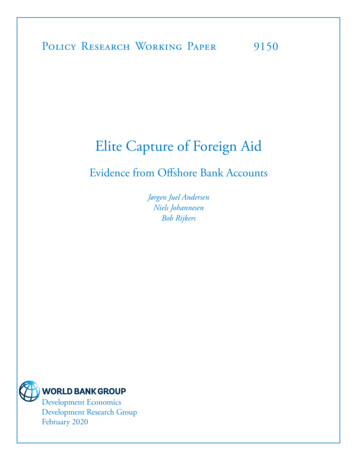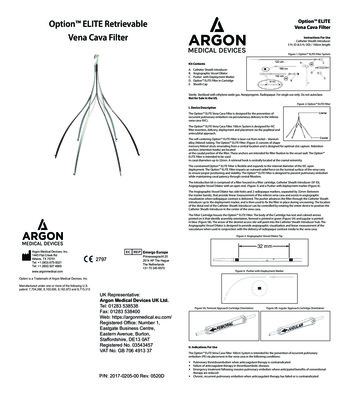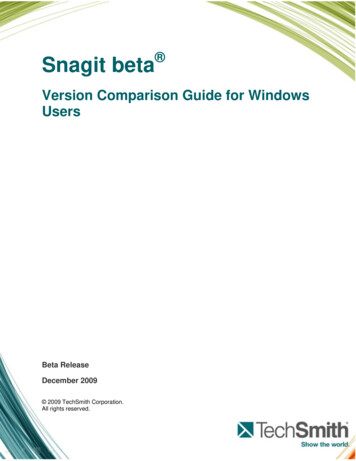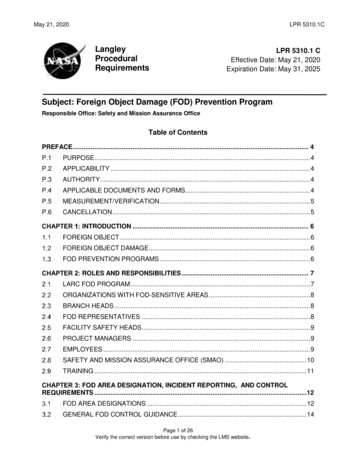
Transcription
Policy Research Working Paper9150Elite Capture of Foreign AidEvidence from Offshore Bank AccountsJørgen Juel AndersenNiels JohannesenBob RijkersDevelopment EconomicsDevelopment Research GroupFebruary 2020
Policy Research Working Paper 9150AbstractDo elites capture foreign aid? This paper documents that aiddisbursements to highly aid-dependent countries coincidewith sharp increases in bank deposits in offshore financialcenters known for bank secrecy and private wealth management, but not in other financial centers. The estimatesare not confounded by contemporaneous shocks such ascivil conflicts, natural disasters, and financial crises, andare robust to instrumenting with predetermined aid commitments. The implied leakage rate is around 7.5 percentat the sample mean and tends to increase with the ratio ofaid to GDP. The findings are consistent with aid capturein the most aid-dependent countries.This paper is a product of the Development Research Group, Development Economics. It is part of a larger effort by theWorld Bank to provide open access to its research and make a contribution to development policy discussions around theworld. Policy Research Working Papers are also posted on the Web at http://www.worldbank.org/prwp. The authors maybe contacted at niels.johannesen@econ.ku.dk, brijkers@worldbank.org, and jorgen.j.andersen@bi.no.The Policy Research Working Paper Series disseminates the findings of work in progress to encourage the exchange of ideas about developmentissues. An objective of the series is to get the findings out quickly, even if the presentations are less than fully polished. The papers carry thenames of the authors and should be cited accordingly. The findings, interpretations, and conclusions expressed in this paper are entirely thoseof the authors. They do not necessarily represent the views of the International Bank for Reconstruction and Development/World Bank andits affiliated organizations, or those of the Executive Directors of the World Bank or the governments they represent.Produced by the Research Support Team
Elite Capture of Foreign Aid: Evidence from OffshoreBank Accounts Jørgen Juel Andersen (BI Norwegian Business School)Niels Johannesen (University of Copenhagen and CEBI)Bob Rijkers (The World Bank)February 18, 2020JEL: D73; F35, P16 Jørgen Juel Andersen: jorgen.j.andersen@bi.no; Niels Johannesen: niels.johannesen@econ.ku.dk; Bob Rijkers: brijkers@worldbank.org. We thank Simeon Djankov, Shanta Devarajan, Eric Feyen, Caroline Freund,Francisco Ferreira, Penny Goldberg, Aart Kraay, Pablo Selaya, Stuti Khemani, Aaditya Mattoo, William Maloney, Steven Pennings, Finn Tarp, Emile Van Der Does De Willebois, and the World Bank’s Chief EconomistCouncil for excellent comments and Jarret Angbazo and Nicolas Gomez Parra for helpful research assistance.Research for this paper has been supported in part by the Knowledge for Change Program, the MultidonorTrust Fund for Trade and Development, and the Strategic Research Program of the World Bank. Andersengratefully acknowledges support from the Research Council of Norway, Grant. No. 275387, and from Centrefor Applied Macroeconomics and Commodity Prices, BI Norwegian Business School. Johannesen gratefullyacknowledges financial support from the Danish Council for Independent Research and the Danish NationalResearch Foundation. The findings, interpretations, and conclusions expressed in the paper are entirely thoseof the authors. They do not necessarily represent the views of the International Bank of Reconstruction andDevelopment / World Bank and its affiliated organizations, or those of the Executive Directors of the WorldBank or the countries they represent. All errors are our responsibility.
1IntroductionThe effectiveness of foreign aid remains controversial. A large literature studies how aid is spent(Werker et al., 2009); how it is absorbed in the domestic economy (Temple and van de Sijpe,2017); and how much it ultimately stimulates growth (Dalgaard et al., 2004), improves humandevelopment outcomes (Boone, 1996), and reduces poverty (Collier and Dollar, 2002). In lightof the evidence, some scholars assert that aid plays a pivotal role in promoting economic development in the poorest countries (Sachs, 2005) while others are highly skeptical (Easterly, 2006).Many studies emphasize that aid effectiveness depends crucially on the quality of institutionsand policies in the receiving countries (Burnside and Dollar, 2000).A concern often voiced by skeptics is that aid may be captured by economic and politicalelites. The fact that many of the countries that receive foreign aid have high levels of corruption(Alesina and Weder, 2002) invokes fears that aid flows end up in the pockets of the rulingpoliticians and their cronies. This would be consistent with economic theories of rent seeking inthe presence of aid (Svensson, 2000) and resonate with colorful anecdotal evidence about faileddevelopment projects and self-interested elites (Klitgaard, 1990). Yet, there is little systematicevidence on diversion of aid.In this paper, we study aid diversion by combining quarterly information on aid disbursements from the World Bank (WB) and foreign deposits from the Bank for International Settlements (BIS). The former dataset covers all disbursements made by the World Bank to financedevelopment projects and provide general budget support in its client countries. The latterdataset covers foreign-owned deposits in all significant financial centers, both havens such asSwitzerland, Luxembourg, Cayman Islands and Singapore whose legal framework emphasizessecrecy and asset protection and non-havens such as Germany, France and Sweden.Equipped with this dataset, we study whether aid disbursements trigger money flows toforeign bank accounts. In our main sample comprising the 22 most aid-dependent countries inthe world (in terms of WB aid), we document that disbursements of aid coincide, in the samequarter, with significant increases in the value of bank deposits in havens. Specifically, in aquarter where a country receives aid equivalent to 1% of GDP, its deposits in havens increaseby 3.4% relative to a country receiving no aid; by contrast, there is no increase in deposits heldin non-havens. While other interpretations are possible, these findings are suggestive of aiddiversion to private accounts in havens.One may be concerned that the results are confounded by factors affecting both aid inflowsand capital outflows. We address this potential endogeneity in three ways. First, we augment1
the baseline model with leads and lags of the aid variable. Reassuringly, we find no differential trends in deposits during the quarters prior to aid disbursements. Second, we instrumentdisbursements with pre-determined aid commitments, which are plausibly exogenous to contemporaneous shocks (Kraay, 2012, 2014). The IV estimates are qualitatively similar, but somewhatsmaller than the OLS estimates. Third, we exclude observations where specific events such aswars, natural disasters and financial crises might cause both inflows of aid and outflows of domestic capital and introduce controls for potential confounders such as oil prices and exchangerates. We also estimate specifications with country-year fixed effects where identification comesexclusively from variation in the timing of disbursements within the year. The main results arerobust to all these tests.While our results document cleanly and robustly that aid disbursements are associated withwealth accumulation in offshore accounts, the macro nature of our deposit information representsan important limitation: since we do not observe who stores wealth in havens in periods withlarge aid disbursements, we cannot directly identify the economic mechanism underlying thiscorrelation.Despite this inherent limitation, it is almost certain that the beneficiaries of the moneyflowing to havens at the time of aid disbursements belong to economic elites. Recent researchusing micro-data from data leaks and tax amnesties documents that offshore bank accountsare overwhelmingly concentrated at the very top of the wealth distribution.1 By contrast, thepoorest segments in developing countries often do not even have a domestic bank account (WorldBank, 2017) and it is entirely implausible that they should control the money flows to havens.While it is more difficult to identify the precise mechanism by which aid inflows causecapital outflows to havens, aid capture by ruling politicians and bureaucrats is a salient andplausible one. First, it can explain why the trail leads to havens rather than non-havens: ifthe money derives from corruption and embezzlement, we should not be surprised to see itflowing to jurisdictions with legal institutions emphasizing secrecy.2 Second, it can explain whywe observe a sharp and immediate increase in deposits in the disbursement quarter with noincreases in subsequent quarters: to the extent political elites divert aid to foreign accounts,either directly or through kickbacks from private sector cronies, aid inflows and capital outflows1Alstadsæter et al. (2019) find that around 50% of the assets hidden in havens by Scandinavians belong tothe 0.01% wealthiest households and 80% belong to the wealthiest 0.1%. Londono-Velez and Avila (2018) findsimilar results for Colombia.2Anecdotally, havens are often associated with the laundering of proceeds from high-level corruption. Forinstance, a report by the Financial Action Task Force describes 32 cases of grand corruption of which 21 involvedbank accounts in havens (FATF, 2011).2
should occur almost simultaneously. Third, our analysis of heterogeneity is consistent withcorruption mediating the effect of aid on wealth in havens: we find larger estimates in morecorrupt countries although the difference is not statistically significant. In any case, since moneyis fungible we cannot distinguish between direct diversion of the funds disbursed by the donorand diversion of other public funds freed up by the aid disbursement.Some alternative interpretations exist, but we find them harder to reconcile with all thepatterns in the data. Most importantly, firms directly involved in aid-sponsored projects mayreceive payments in quarters with aid disbursements and deposit some of these funds with foreignbanks. One set of results provides some support for this explanation: we find larger estimates incountries with less private credit suggesting that foreign banks serve as a substitute for inefficientdomestic banks. However, this mechanism does not explain our finding that money only flows toplaces like Zurich, the global center for bank secrecy and private wealth management (Zucman,2017), and not to other international banking centers like New York, London and Frankfurt.The dynamics in haven deposits, a permanent level shift at the time of aid disbursements, alsoseems more consistent with personal wealth accumulation than firm cash management.There are other mechanisms that we can more confidently rule out. First, firms in developing countries have been shown to engage in aggressive tax avoidance by shifting profits tolow-tax affiliates (Johannesen et al., 2016), but such profit shifting cannot explain our resultsbecause of the way the BIS statistics are constructed: deposits belonging to the Bermuda subsidiary of a Tanzanian company are assigned to Bermuda rather than Tanzania. Second, aidmay increase income more broadly in the economy by stimulating aggregate demand and maytherefore indirectly increase evasion of personal income taxes through havens; however, ourmodel accounts for aggregate income shocks by conditioning on GDP growth and the sharpincrease in haven deposits in the disbursement quarter does not mirror the typically protractedexpansionary effect of economic stimulus (Kaplan and Violante, 2014). Finally, we can excludethat our results reflect portfolio adjustments by commercial or central banks as our depositvariables only include foreign deposits belonging to non-banks.It is natural to express the estimates as a leakage rate: the dollar increase in haven depositsassociated with a 100 dollar aid disbursement. Our model does not deliver this parameterdirectly and we therefore rely on the following transformation. Our key estimate suggests thataid corresponding to 1% of GDP increases deposits in havens by around 3.4%. While thereis considerable variation over time and across the highly aid dependent countries in our mainsample, the stock of deposits in havens stands at around 2.2% of GDP at the sample mean; hence3
a 3.4% increase in haven deposits corresponds to around 0.075% of GDP (i.e. 2.2%*3.4%) andthe implied average leakage rate is approximately 7.5% (i.e. 0.075%/1%). A simple simulationthat weighs countries by their historical share of aid disbursements and accounts for crosscountry differences in the ratio of haven deposits to GDP, implies a leakage rate of around 5%in aggregate disbursements. These modest leakage rates represent a lower bound in the sensethat they only include aid diverted to foreign accounts and not money spent on real estate,luxury goods etcetera.While the leakage estimates reported above are averages for those countries with annual aidfrom the World Bank above 2% of GDP, we show that leakage rates exhibit a strong gradient inaid-dependence, both within this sample and beyond. On the one hand, lowering the thresholdto 1% of GDP (sample of 46 countries), we cannot reject the null hypothesis of no leakage. Thissuggests that the average leakage rate across all aid-receiving countries is much smaller thanthe estimates obtained from the main sample, which account for less than 10% of all WorldBank aid. On the other hand, raising the threshold to 3% of GDP (sample of 7 countries), wefind a higher leakage rate of around 15%. This pattern is consistent with existing findings thatthe countries attracting the most aid are not only among the least developed but also amongthe worst governed (Alesina and Weder, 2002) and that very high levels of aid might fostercorruption and institutional erosion (Knack, 2000; Djankov et al., 2008).While the comprehensive deposit dataset employed in the main analysis is restricted andsubject to confidentiality requirements, we also study publicly available series recently releasedby the BIS. This allows us to study deposits in some individual havens: we find that bankaccounts in Switzerland and Luxembourg contribute significantly to the correlation betweenaid disbursements and haven deposits whereas accounts in Belgium and Jersey do not. Thepublic series also allow us to extend the sample period to more recent years where financialtransparency has improved significantly. We find similar point estimates for the periods beforeand after 2009 suggesting that the relationship between aid and hidden wealth is unchanged.However, since our leakage estimates for short subperiods are imprecise, we cannot rule out thatfinancial transparency has curbed diversion of aid.The paper contributes to the understanding of aid effectiveness by empirically identifyingand quantifying a mechanism that may render aid ineffective: elite capture. In doing so, wecontribute to literatures on the distributional effects of aid (Bjørnskov, 2010); hidden wealthand its origins (Zucman, 2013); and capital flight (Johannesen and Pirttillä, 2016). Our resultsand empirical approach are most closely related to the finding that petroleum rents are partly4
shifted to bank accounts in havens when political institutions are weak (Andersen et al., 2017).Last, our results contribute to the broader literature on political corruption (Olken and Pande,2012).The remainder of the paper is organized as follows. Section 2 describes our key variables.Section 3 explains our empirical strategy. Section 4 presents the results. A final section concludes.2Data2.1Cross-border bank depositsWe use data on foreign bank deposits from the Locational Banking Statistics of the Bankfor International Settlements (BIS). This quarterly dataset has information on the value ofbank deposits in 43 financial centers owned by residents of around 200 countries. The depositinformation is at the bilateral level, e.g. the value of deposits in Swiss banks owned by residentsof Tanzania, and builds on confidential reports from individual banks on their foreign positions.Importantly, deposits are assigned to countries based on immediate ownership rather thanbeneficial ownership; hence, if a Tanzanian firm has a subsidiary in Bermuda, which holds aSwiss bank account, the account is assigned to Bermuda in the BIS statistics.The dataset covers the vast majority of the world’s cross-border bank deposits: all significantbanking centers contribute to the dataset and within each banking center coverage is rarely below90% (BIS, 2011). This is one of the most reliable sources for information about foreign assets andis therefore frequently used by central banks to construct capital accounts; by macroeconomiststo gauge net wealth positions (Lane and Milesi-Ferretti, 2007; Zucman, 2013); and by publicfinance economists to study offshore tax evasion (Johannesen, 2014; Johannesen and Zucman,2014).While the BIS generally makes deposit information publicly available at the country level(e.g. deposits held by Tanzanians in all foreign banking centers combined and deposits heldin Cayman banks by all foreigners combined), it has traditionally restricted access to depositinformation at the bilateral level (e.g. deposits held by Tanzanians in Cayman banks) to centralbank staff and external researchers working under a confidentiality agreement with the BIS. Inthe main analysis, we use a dataset with restricted information at the bilateral level up until2010, which allows us to break down each country’s total foreign deposits into deposits in havensand deposits in non-havens. In an auxiliary analysis, we exploit recently released information at5
the bilateral level for selected banking centers. While the public dataset is not as comprehensiveas the restricted one, it allows us to extend the sample period beyond 2010 and to show resultsfor individual havens, which is prohibited under the confidentiality agreement governing therestricted data.Among the 43 financial centers contributing to the Locational Banking Statistics, we classify17 as havens and the remaining 26 as non-havens.3 Havens generally have institutional characteristics that make them attractive places to hide funds: bank secrecy rules that ensure strictconfidentiality and legal arrangements that facilitate asset protection by enabling investors tonominally transfer asset ownership to a third party while retaining full control (e.g. trusts orde facto anonymous shell corporations). Important havens in our dataset include Switzerland,Luxembourg, Cayman Islands, Bahamas, Hong Kong and Singapore.4We define Havenit as deposits owned by country i in the 17 havens in quarter t, and similarlyN onhavenit as deposits owned in one of the other financial centers. We exploit the sectoralbreakdown in the BIS statistics to exclude interbank deposits from these measures.5 The BISstatistics do not look through chains of ownership to the ultimate owners of deposits; our analysisdoes therefore not include accounts held through foreign shell corporations (Omartian, 2017),which is likely to reduce the estimated leakage. The dataset at our disposal spans the period1977-2010, but we discard observations before 1990 because of a major data break in 1989.6Table 1 presents summary statistics on the deposit measures. Average haven deposits rangefrom 4 million in Sao Tome and Principe to almost 200 million in Madagascar and generallyconstitute around one third of all foreign deposits. Quarterly growth rates in haven deposits, ourmain outcome variable, average 2.0%, which is significantly higher than the quarterly growthrate in non-haven deposits and GDP. The distribution of growth rates in haven deposits isdisplayed in Figure A1 in the Online Appendix.3Our classification of financial centers as havens and non-havens follows Andersen et al. (2017): to the set offinancial centers identified by the OECD in 2008 as not providing bank information to foreign governments onrequest, they add Macao, SAR, China, and Hong Kong, SAR, China. Table A1 in the Online Appendix providesa list of havens ranked by the total value of foreign-owned deposits in their banks.4In response to strong international pressure, legal institutions in havens have changed considerably in thepast decade. Starting around 2009, all havens committed to some measure of information exchange with othercountries for tax enforcement purposes (Johannesen and Zucman, 2014).5This also excludes foreign deposits held by central banks, which is important to avoid confounding effectsthrough placement of foreign reserves.6Until 1989, the Locational Banking Statistics did not include fiduciary deposits in Swiss banks, the lion’sshare of foreign-owned deposits in Switzerland, as they were considered off-balance sheet items by the BIS.6
2.2Foreign aidWe first construct a project-level database of aid disbursements from the World Bank throughits two principal institutions, the International Development Association (IDA) and the International Bank for Reconstruction and Development (IBRD). From the World Bank ProjectDatabase (so-called API data), we obtain information on approval date, commitment amount,sector and instrument type for each project. We combine this dataset with monthly project-levelinformation on disbursements from Kersting and Kilby (2016).7Next, we draw on this database to construct our main aid variable, Aidit , which aggregatesdisbursements from the World Bank across all projects in a given country i in a given quartert. By construction, this variable does not include aid from other sources such as humanitarianassistance and development aid from individual countries. It also excludes debt relief. The mainreason to focus on aid from the World Bank is that we observe the timing of disbursements withinthe year, which is important for empirical identification because the main effect shows up atquarterly frequency. Data on other sources of aid, including the leading aggregate measureof development aid Official Development Assistance (ODA), is typically available only at theannual frequency. Further, the fact that Word Bank disbursement data is available at the levelof individual projects allows us to implement an instrumental variables strategy (see below).Our main sample consists of the 22 countries that, on average over the sample period 19902010, receive annual disbursements from the World Bank equivalent to at least 2% of GDP.8 Asshown in Table 1, annual aid disbursements from the World Bank are almost 3% of GDP onaverage whereas development aid from all sources exceeds 10% of GDP on average. Foreign aidis thus a major source of income within this sample. The distribution of our main explanatoryvariable, the ratio of quarterly aid disbursements from the World Bank to annual GDP, isdisplayed in Figure A2 in the Online Appendix: aid disbursements exceed 1% of GDP in around25% of the quarters and exceed 2% of GDP in around 5% of the quarters.Aid disbursements are potentially endogenous to contemporaneous economic shocks and,building on Kraay (2012, 2014), we therefore construct an instrument that exploits the time lagbetween commitments and disbursements of aid.9 After a World Bank project is approved, dis7While the World Bank Project Database contains information on disbursements, it does not allow forbulk download. Kersting and Kilby (2016) retrieve the disbursement information from the database using anautomated script.8In extensions, we also study a broader set of countries with annual disbursements above 1% of GDP.9Existing studies have used other instruments for aid. Werker et al. (2009) use oil price variation to instrumentaid provided by OPEC members. Galliani et al. (2017) exploit the crossing of the IDA eligibility threshold toassess the impact of aid on growth.7
bursements are usually spread out over many quarters at different stages of the project. Actualdisbursements may deviate substantially from the originally planned disbursement schedule; forinstance, disbursements may be accelerated in response to natural disasters or delayed in theface of civil conflict. However, the amount of aid disbursed in a given quarter is largely theresult of project approvals made in previous quarters, which creates variation in disbursementsthat is arguably exogenous to contemporaneous shocks.Following Kraay (2012, 2014), we build an instrument by predicting quarterly disbursementsfor each project based on the initial commitment and the average disbursement schedule acrossall other projects implemented in the same sector and the same geographical region. Summingover predicted disbursement at the project-level, we predict aggregate disbursements for eachcountry and quarter.10 We never use predicted disbursements for the commitment quarter asan instrument since it suffers from the same potential endogeneity as the actual disbursements.In the most rigorous tests, we only use predicted disbursements related to projects approved atleast 3 quarters before as an instrument to strengthen the case for exogeneity.2.3Other variablesWe collect information about events that may be associated with simultaneous changes in aid disbursements and cross-border capital flows: Wars from the PRIO Armed Conflict Dataset; Coupsfrom Powell and Thyne (2011); Natural disasters from the International Disaster Database; Financial crisis from Laeven and Valencia (2012); Petroleum rents and financial sector developmentfrom World Development Indicators (WDI). We also collect information on country characteristics that may mediate the effect of aid disbursements on haven deposits: Corruption fromWorldwide Governance Indicators (WGI); Disclosure requirements for members of parliamentfrom Djankov et al. (2010); Capital account openness from Chinn and Ito (2006); Politicalregime characteristics from the Polity IV Project. We document these variables in more detailand provide summary statistics in Table A2 in the Online Appendix.3Empirical strategyTo assess whether disbursements of aid are accompanied by money flows to havens, we estimatethe following baseline model: log(Havenit ) βAidit γXit µt τi it10The analysis is limited to projects that were approved after 1984.8
where log(Havenit ) measures the growth rate in haven deposits owned by country i inquarter t, Aidit measures aid disbursements to country i in quarter t as a share of GDP, Xit is avector of control variables (including notably GDP growth) and µi and τt represent country andtime fixed effects respectively.11 Conceptually, the equation thus relates two flows of money:flows from the World Bank on the right-hand side and (net) flows to foreign bank accounts onthe left-hand side.The main parameter of interest, β, expresses the percentage change in haven deposits associated with an aid disbursement equivalent to one percent of GDP. It is measured relativeto the counterfactual change in haven deposits given by the other variables in the model: thecountry’s long-run average growth rate in haven deposits (captured by country fixed effects),global shocks to haven deposits (captured by the time fixed effects) and local shocks to income(captured by the control for GDP growth). The presence of country fixed effects implies that βis identified exclusively from within-country variation. We are effectively asking whether havendeposits grow more than the country average in quarters where aid exceeds the country averagewhile absorbing the global trend in cross-border capital flows and the effect of the local businesscycle.To distinguish between cross-border money flows motivated by secrecy and asset protectionand those motivated by other concerns, we also estimate the baseline model using the growthrate in deposits in non-havens, log(N onhaven), as dependent variable. We compare the estimated coefficients on Aid in the two regressions and, as a more formal test for differential growthrates in haven and non-haven deposits induced by aid disbursements, additionally estimate thebaseline model using the differential growth rate, log(Haven) log(N onhaven), directlyas dependent variable. This specification identifies the impact of aid on haven deposits whileabsorbing any shocks to cross-border flows that are shared between haven and non-haven accounts.This is a very conservative test for potential diversion, since it assumes aid capture wouldonly result in flows to havens; potential diversion to nonhavens would result in a downward bias.The main threat to identification in the baseline model is the potential endogeneity of aid.There could be macroeconomic shocks, such as financial crises or famine, that simultaneouslycause capital flight and a surge in foreign aid, leading to a spurious positive correlation betweenaid disbursements and foreign deposits. Alternatively, opportunistic behavior by politicianscould result in capital flight and induce foreign donors to cut back on aid suggesting that thecorrelation between aid and haven deposits might be spuriously negative.11In the main specification, deposit and aid variables are winsorized at the 1%/99% level to reduce the impactof extreme values. We obtain similar results using non-winsorized variables as is shown in column 11 of Table 3.9
We address this potential endogeneity problem in three ways. First, we exploit the highfrequency nature of our data and test for pre-existing differential trends in haven deposits byadding leading values of aid disbursements to the estimating equation. Non-zero coefficients onthe leading disbursements are suggestive of endogeneity. Second, we instrument aid disbursements with their pred
Bank, 2017) and it is entirely implausible that they should control the money ows to havens. While it is more di cult to identify the precise mechanism by which aid in ows cause capital out ows to havens, aid capture by ruling politicians and bureaucrats is a salient and plausible one. First, it can explain why the trail leads to havens rather .










